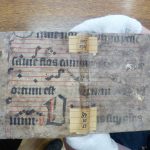The fragment belonged to the Antiphonale Strigoniense I. 3c of the Esztergom Cathedral Library (Bibliotheca Ecclesiae Metropolitanae Strigoniensis), one of the basic Hungarian plainchant sources (online acces: http://esztergom.bibliotheca.hu/scan/ms_i_3_c/index.html). Only one single chant is preserved: the responsory Salve nobilis virga Iesse for the Virgin Mary, with its verse Odor tuus super cuncta. This chant is part of a series of responsories attributed to Fulbert of Chartres, composed at the beginning of the 11th century. The cycle was completed with new, probably locally composed pieces during the 12th century, and organized as series for Matins following almost exactly the modal order. The O decus cycle, named in the Hungarian tradition after its first chant (O decus virginitatis) contains 9 responsories. It was part of the daily commune de beata office of Mary, often placed as an appendix after the office of Assumptio in antiphonals and breviaries. In some cases the chants were anticipated at the vigil of the feast. The mother codex of the fragment, the Esztergom Antiphonal contains only a single responsory from the O decus cycle (f. 5v Fulcite me floribus, at the end of the office of Assumptio), therefore it is not certain, to which Marian office the fragment’s responsory Salve nobilis belonged. The fragmentary folio can likely be put virtually before the present-day corpus of the mother codex, assuming, that the Salve nobilis was placed at the end of Assumption’s Matins, or even earlier, in the Vigil of the Office.
Zsuzsa Czagány


